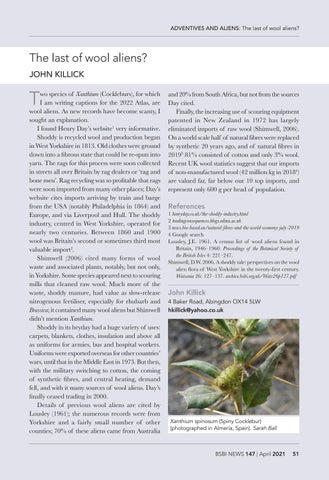ADVENTIVES AND ALIENS: The last of wool aliens?
The last of wool aliens? JOHN KILLICK
T
wo species of Xanthium (Cockleburs), for which I am writing captions for the 2022 Atlas, are wool aliens. As new records have become scanty, I sought an explanation. I found Henry Day’s website1 very informative. Shoddy is recycled wool and production began in West Yorkshire in 1813. Old clothes were ground down into a fibrous state that could be re-spun into yarn. The rags for this process were soon collected in streets all over Britain by rag dealers or ‘rag and bone men’. Rag recycling was so profitable that rags were soon imported from many other places; Day’s website cites imports arriving by train and barge from the USA (notably Philadelphia in 1864) and Europe, and via Liverpool and Hull. The shoddy industry, centred in West Yorkshire, operated for nearly two centuries. Between 1860 and 1900 wool was Britain’s second or sometimes third most valuable import2. Shimwell (2006) cited many forms of wool waste and associated plants, notably, but not only, in Yorkshire. Some species appeared next to scouring mills that cleaned raw wool. Much more of the waste, shoddy manure, had value as slow-release nitrogenous fertiliser, especially for rhubarb and Brassica; it contained many wool aliens but Shimwell didn’t mention Xanthium. Shoddy in its heyday had a huge variety of uses: carpets, blankets, clothes, insulation and above all as uniforms for armies, bus and hospital workers. Uniforms were exported overseas for other countries’ wars, until that in the Middle East in 1973. But then, with the military switching to cotton, the coming of synthetic fibres, and central heating, demand fell, and with it many sources of wool aliens. Day’s finally ceased trading in 2000. Details of previous wool aliens are cited by Lousley (1961); the numerous records were from Yorkshire and a fairly small number of other counties; 70% of these aliens came from Australia
and 20% from South Africa, but not from the sources Day cited. Finally, the increasing use of scouring equipment patented in New Zealand in 1972 has largely eliminated imports of raw wool (Shimwell, 2006). On a world scale half of natural fibres were replaced by synthetic 20 years ago, and of natural fibres in 20193 81% consisted of cotton and only 3% wool. Recent UK wool statistics suggest that our imports of non-manufactured wool (42 million kg in 20184) are valued far, far below our 10 top imports, and represent only 600 g per head of population.
References
1 henryday.co.uk/the-shoddy-industry.html 2 tradingconsequences.blogs.edina.ac.uk 3 news.bio-based.eu/natural-fibres-and-the-world-economy-july-2019 4 Google search Lousley, J.E. 1961. A census list of wool aliens found in Britain, 1946–1960. Proceedings of the Botanical Society of the British Isles 4: 221–247. Shimwell, D.W. 2006. A shoddy tale: perspectives on the wool alien flora of West Yorkshire in the twenty-first century. Watsonia 26: 127–137. archive.bsbi.org.uk/Wats26p127.pdf
John Killick 4 Baker Road, Abingdon OX14 5LW hkillick@yahoo.co.uk
Xanthium spinosum (Spiny Cocklebur) (photographed in Almería, Spain). Sarah Ball
BSBI NEWS 147 | April 2021
51
















